
Ulmus 'San Zanobi' is a hybrid elm cultivar raised by the Istituto per la Protezione delle Piante (IPP) in Florence, from a crossing of the Dutch hybrid 'Plantyn' and the Siberian Elm Ulmus pumila clone 'S 15'; it was released to commerce in 2002. 'San Zanobi' was introduced to the UK in 2004 by Hampshire & Isle of Wight Branch, Butterfly Conservation, as part of its assessment of DED-resistant cultivars as potential hosts of the endangered White-letter Hairstreak.

Ulmus 'Plinio' is a hybrid elm cultivar derived from a crossing of the Dutch cultivar 'Plantyn' with the Siberian Elm Ulmus pumila clone 'S.2'. 'Plinio' was raised by the Istituto per la Protezione delle Piante (IPP), in Florence and released for sale in 2003. 'Plinio' was introduced to the UK in 2004 by Hampshire & Isle of Wight Branch, Butterfly Conservation, as part of its assessment of DED-resistant cultivars as potential hosts of the endangered White-letter Hairstreak.

Ulmus wallichianaPlanch., the Himalayan elm, also known as the Kashmir elm and Bhutan elm, is a mountain tree ranging from central Nuristan in Afghanistan, through northern Pakistan and northern India to western Nepal at elevations of 800–3000 m. Although dissimilar in appearance, its common name is occasionally used in error for the cherry bark elm Ulmus villosa, which is also endemic to the Kashmir, but inhabits the valleys, not the mountain slopes. The species is closely related to the wych elm U. glabra.

Ulmus 'Nanguen' is a complex fourth generation Dutch hybrid cultivar raised at the Dorschkamp Research Institute for Forestry & Landscape Planning, Wageningen. Lutèce was derived from the cross 'Plantyn' ×, an ancestry comprising four field elms, a wych elm, the curious Exeter Elm ('Exoniensis'), and a frost-resistant selection of the Himalayan elm.

Ulmus 'New Horizon' is an American hybrid cultivar raised by the Wisconsin Alumni Research Foundation (WARF), from a crossing of the Japanese Elm clone W43-8 = 'Reseda' with Siberian Elm clone W426 grown from seed collected from a street tree at Yankton, South Dakota. Tested in the US National Elm Trial coordinated by Colorado State University, 'New Horizon' averaged a survival rate of 74% after 10 years.'New Horizon' was patented in the US in 1994, while in Europe, it is marketed as one of the 'Resista' elms protected under EU breeders' rights.

Ulmus laciniata(Trautv.) Mayr, known variously as the Manchurian, cut-leaf, or lobed elm, is a deciduous tree native to the humid ravine forests of Japan, Korea, northern China, eastern Siberia and Sakhalin, growing alongside Cercidiphyllum japonicum, Aesculus turbinata, and Pterocarya rhoifolia, at elevations of 700–2200 m, though sometimes lower in more northern latitudes, notably in Hokkaido.

Ulmus 'Homestead' is an American hybrid elm cultivar raised by Alden Townsend of the United States National Arboretum at the Nursery Crops Laboratory in Delaware, Ohio. The cultivar arose from a 1970 crossing of the Siberian Elm Ulmus pumila with the hybrid N 215, the latter grown from seed sent in 1960 to the University of Wisconsin-Madison elm breeding team by Hans Heybroek of the De Dorschkamp Research Institute in the Netherlands. Tested in the US National Elm Trial coordinated by Colorado State University, 'Homestead' averaged a survival rate of 85% after 10 years. 'Homestead' was released to commerce without patent restrictions in 1984.
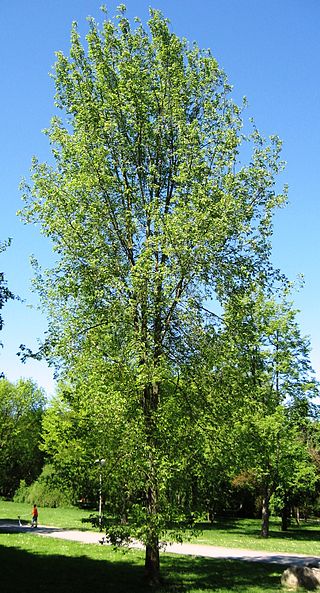
Ulmus 'Regal' is an American hybrid elm cultivar developed by the University of Wisconsin–Madison and released in 1983. 'Regal' was derived from seeds arising from the crossing of the Dutch hybrid clones 'Commelin' and '215' sent in 1960 by Hans M. Heybroek of the Dorschkamp Research Institute for Forestry & Landscape Planning, Wageningen, Netherlands.

Ulmus 'Sapporo Autumn Gold' is one of the most commercially successful hybrid elm cultivars ever marketed, widely planted across North America and western Europe, although it has now been largely supplanted by more recent introductions. Arising from a chance crossing of the Japanese elm and Siberian elm, seed was sent in 1958 by Prof. Nobuku Takahashi and his colleagues at the Sapporo Botanical Garden of Hokkaido University, Sapporo, to Eugene Smalley at the University of Wisconsin–Madison. The patent issued in 1975 has expired, and there are now no propagation restrictions.
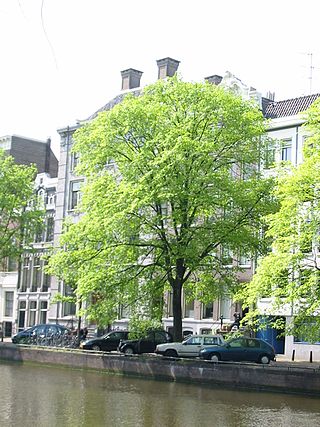
The hybrid elm cultivar Ulmus × hollandica 'Belgica', one of a number of hybrids arising from the crossing of Wych Elm with a variety of Field Elm, was reputedly raised in the nurseries of the Abbey of the Dunes, Veurne, in 1694. Popular throughout Belgium and the Netherlands in the 19th century both as an ornamental and as a shelter-belt tree, it was the 'Hollandse iep' in these countries, as distinct from the tree known as 'Dutch Elm' in Great Britain and Ireland since the 17th century: Ulmus × hollandica 'Major'. In Francophone Belgium it was known as orme gras de Malines.

Ulmus 'Wanoux' is a Dutch hybrid cultivar raised at the Dorschkamp Research Institute for Forestry & Landscape Planning, Wageningen, from an open pollination of 'Plantyn'. Originally identified as clone No. 762, it was selected for assessment by the French Institut National de la Recherche Agronomique (INRA), which patented it as 'Wanoux' in 2006.

The American Elm cultivar Ulmus americana 'Princeton' was originally selected in 1922 by New Jersey nurseryman William Flemer of Princeton Nurseries for its aesthetic merit. 'Princeton' was later found to have a moderate resistance to Dutch elm disease (DED).

The Japanese elm cultivar Ulmus davidianavar.japonica 'Prospector' was originally treated as a cultivar of Wilson's elm U. wilsonianaSchneid., a species sunk as Ulmus davidiana var. japonica by Fu. A U.S. National Arboretum introduction, it was selected in 1975 from a batch of 1965 seedlings in Delaware, Ohio, and released without patent restrictions in 1990. 'Prospector' proved moderately successful in the US National Elm Trial, averaging a survival rate of 76% overall.
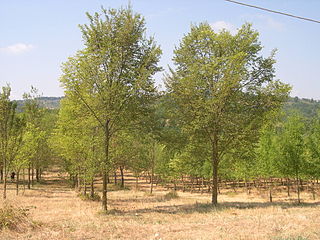
Ulmus 'Arno' is an Italian hybrid cultivar derived from a crossing of 'Plantyn' with the Siberian Elm Ulmus pumila clone S.2. It was raised by the Istituto per la Protezione delle Piante (IPP) in Florence, and released in 2007. However, 'Arno' was not a commercial success; propagation had ceased by 2010, and it is no longer patent protected.
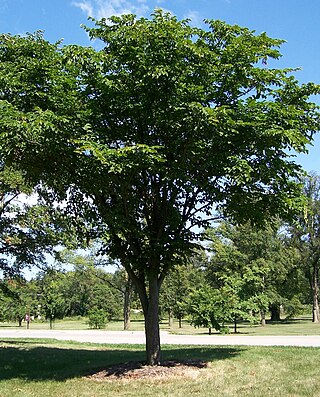
Ulmus laciniata var. nikkoensisRehder, the Nikko elm, was discovered as a seedling near Lake Chūzenji, near Nikkō, Japan, and obtained by the Arnold Arboretum in 1905. The taxonomy of the tree remains a matter of contention, and has been considered possibly a hybrid of U. laciniata and U. davidiana var. japonica. However, in crossability experiments at the Arnold Arboretum in the 1970s, U. laciniata, a protogynous species, was found to be incompatible with U. davidiana var. japonica, which is protandrous.
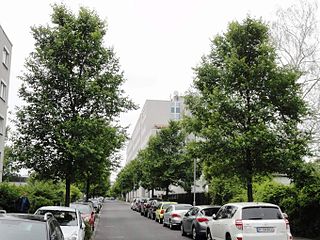
Ulmus 'Rebona' is an American hybrid cultivar raised by the Wisconsin Alumni Research Foundation (WARF) as selection 'W916', derived from a crossing of Japanese Elm clone W43-8 = 'Reseda' with Siberian Elm clone W426 grown from seed collected from a street tree at Yankton, South Dakota. The tree was registered in 1993 by Conrad Appel KG, of Darmstadt and is a sibling of 'New Horizon'. In Europe, 'Rebona' is marketed as a Resista elm protected under E U breeders' rights.

The Siberian elm cultivar Ulmus pumila 'Pinnato-ramosa' was raised by Georg Dieck, as Ulmus pinnato-ramosa, at the National Arboretum, Zöschen, Germany, from seed collected for him circa 1890 in the Ili valley, Turkestan by the lawyer and amateur naturalist Vladislav E. Niedzwiecki while in exile there. Litvinov (1908) treated it as a variety of Siberian elm, U. pumilavar.arborea but this taxon was ultimately rejected by Green, who sank the tree as a cultivar: "in modern terms, it does not warrant recognition at this rank but is a variant of U. pumila maintained and known only in cultivation, and therefore best treated as a cultivar". Herbarium specimens confirm that trees in cultivation in the 20th century as U. pumilaL. var. arboreaLitv. were no different from 'Pinnato-ramosa'.

Ulmus 'Morfeo' is a hybrid elm cultivar raised by the Istituto per la Protezione delle Piante (IPP), Florence, in 2000. 'Morfeo' arose from a crossing of the Dutch hybrid clone '405' and the Chenmou Elm, the latter a small tree from the provinces of Anhui and Jiangsu in eastern China, The '405' clone is a full sister of 'Groeneveld', a crossing of an English U. × hollandica and a French U. minor from the Barbier Nursery, Orléans.

The field elm cultivar Ulmus minor 'Ademuz' was cloned by root cuttings from a tree assumed to be growing in or near the eponymous town 100 km north-west of Valencia, Spain. The tree was discovered in 1996 by Margarita Burón of the Escuela Técnica Superior de Ingenieros de Montes, Universidad Politėcnica de Madrid (UPM). 'Ademuz' is one of a number of U. minor clones found to have a very high resistance to Dutch Elm Disease, on a par with, if not greater than, the hybrid cultivar 'Sapporo Autumn Gold' grown as a control. In the Madrid study, the appearance of the tree was rated 4.5 / 5, the most attractive of the seven selected cultivars.

Ulmus 'Wingham' is a complex hybrid elm cultivar featuring two Asiatic and two European species, bestowing it with an exceptionally high resistance to Dutch elm disease (DED). It was raised as clone no. FL493 by the Istituto per la Protezione delle Piante (IPP) in Florence, but never patented owing to its limited aesthetic appeal. It was introduced to the UK in 2011 by David Herling, Resistant Elms, who trialled it successfully at Wingham in Kent. It was later trialled by Hampshire & Isle of Wight Branch, Butterfly Conservation, as part of an assessment of DED-resistant cultivars as potential hosts of the endangered White-letter Hairstreak. 'Wingham' was released for sale in the UK in 2019.
























